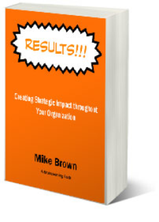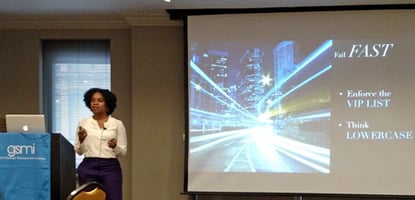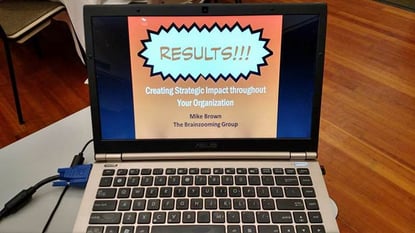A friend recommended the book, The Soul of Desire, by Dr. Curt Thompson (affiliate link), to me. Unrelated, Brainzooming was leading a major visioning and employee engagement assignment for a non-profit client. As with so many things, the two (the book and the employee engagement work) became very related.
The S-Model of Relationships
Dr. Thompson introduced a model linking four S-words to identify the path for developing secure, attached relationships. He applied it to forming personal relationships and bonds as adults; while he doesn’t extend it to employee engagement, it absolutely fits.
Described within an employee engagement context, the model communicates:
- Before individuals feel Secure within an organization, they must be Seen (recognized and known in words and actions).
- Being Seen is a precursor to being Soothed (the organization and leaders addressing and meeting their needs)
- Consistent Soothing behavior creates Safety for employees (this represents a stronger, and deeper emotional connection)
- Finally, an employee with no reason to question Safety develops a Secure sense (freely sharing and embodying the deepest connection)
 A Guide for Re-engaging Employees
A Guide for Re-engaging Employees
The S-model reflected our non-profit client’s employee engagement challenges:
- Employees passionately believed in the organization’s cause
- They were strongly committed to serving patrons and improving their lives
- At the same time, they mistrusted past leadership, and their honeymoon period with the new CEO was waning (they’d heard the talk, but seen little action)
Given the non-profit’s challenges, Brainzooming adapted the S-model. We translated it as a guide for leadership to conduct strategic outreach interactions that consistently recognize where employees are in the model. Given the doubts that employees were raising in honest, authentic ways, we added Skepticism as a fifth S that leadership would need to address. Skepticism can appear anywhere in related to the other steps. It’s a good sign, intriguingly, since it signals that employees are still invested in an organizational relationship.

If you’re thinking about the S-model’s possibilities for your organization, we recommended these strategies within each S-stage:
Seen
- Make a legitimate commitment to learn about, know, and better understand employees. State your intent; let actions live back up the words.
- Ask meaningful questions signaling that you understand employee aspirations and concerns.
- Acknowledge all perspectives, even ones that you disagree with, and honor all perspectives without immediately arguing or trying to prove them wrong.
- Listen more than you talk, and speak authentically to play back what you have heard.
- Remember them in meaningful ways.
Soothe
- Acknowledge their hurts and apprehensions, especially those that you caused.
- Demonstrate that you have seen and heard them accurately. State your appreciation for them engaging now and previously.
- Demonstrate that you see their importance to leadership, the organization, and audiences they serve.
- Do the right things for them, accelerating simple decisions that directly benefit them.
- Let them see that you will act on their behalf, even if you can’t do everything they seek.
- Demonstrate consistent behavior.
Safe
- Be thankful and positive for them, calling them to be their best selves. Both show lavish appreciation and challenge behaviors inconsistent with the organization’s aspirations.
- Display leadership and organizational vulnerability.
- Don’t over- or too quickly react in suspected or extreme ways; be measured in your responses to challenges and difficulties.
- Create opportunities for productive, respectful collaboration between leadership and employees to foster the organization’s future reality.
- Reassure them of your intentions more through behaviors than words.
- Continue acting with consistent behavior.
Secure
- Be consistent in everything.
- Co-create opportunities for bigger and more impactful collaborations.
- Encourage and celebrate smart risk-taking from employees based on their insights, experiences, expertise, and ownership in successful outcomes.
- Shower them with praise for trying and embracing new ways, whether successful or not, as they learn and grow.
- Co-celebrate frequently without hesitation.
- Co-imagine what’s next for the organization, its audiences, employees, and leadership.
Skeptical (The New, Fifth S)
- Acknowledge skepticism; ask questions to demonstrate your respect for and value of the commitment that skepticism implies.
- Continue doing what you said, fulfilling all commitments.
- Follow through on all promises, doing this over a prolonged period to create a lasting impact.
- Act on employee requests for changes and improvements.
- Never waiver from your consistent behaviors.
The First Step is Yours
Applying the S-model will ground your employee engagement expectations and actions in a strategic approach. The model highlights the importance of creating a safe, secure environment for employees before they will give their full selves to bringing about transformation and change. It also orients your leadership team to think and act consistently to foster rebuilding relationships.
Want to discuss your perspectives on this model or employee engagement? Reach out to me. I'd love to learn how you are approaching it. – Mike Brown
If you enjoyed this article, subscribe to the free Brainzooming blog email updates.
10 Employee Engagement Ideas to Improve Strategic Results
FREE Download: "Results!!! Creating Strategic Impact"
Leaders need high-impact ways to develop employees that can provide input into strategic planning and then turn it into results. This Brainzooming mini-book, "Results - Creating Strategic Impact" unveils ten proven lessons leaders can use to boost collaboration, meaningful strategic conversations, and results. Download this free, action-focused mini-book to:
- Learn smart ways to separate strategic opportunities from the daily noise of business
- Increase focus for your team with productive strategy questions everyone can use
- Actively engage stakeholders in strategy AND implementation success





